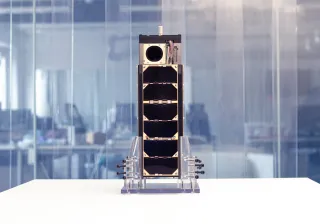The European Space Agency ESA has approved the construction of Comet Interceptor mission and its launch to space. Comet Interceptor, including a main spacecraft and two smaller probes, is equipped with a hyperspectral camera based on VTT’s technology. This technology will provide information about how the Solar System was formed and how it has developed over time.
The probe will target an unseen comet that is on its first approach closer to Sun. These comets originate from the outskirts of our Solar System and have retained almost unaltered since our Solar System formation. The mission can also target an interstellar object from outside our own Solar System if suitable one would be found. The aim is to gain understanding about the birth and evolution of our Solar System and other planetary systems.
Hyperspectral technology provides information about the composition of the comet
VTT and the University of Helsinki, together with the University of Oxford, have developed technology and equipment for collecting information about the comet, with funding from Business Finland, ESA and UK Space Agency. The probe carries equipment – Modular InfraRed Molecules and Ices Sensor (MIRMIS) – that includes hyperspectral camera developed by VTT.
”Hyperspectral remote sensing is used to obtain the optical spectrum of the object at high spatial resolution, providing valuable information about the composition variations within the comet’s nucleus and coma. If we know the composition, we gain understanding about the comet’s birth mechanisms. When it comes to their composition, the ancient comets from outer Solar System represent the situation that prevailed when our Solar System was in the making. VTT’s hyperspectral (camera) technology, as part of the MIRMIS equipment, is a compact instrument, yet reaching a comprehensive measurement capability”, says Antti Näsilä, Research Team Leader at VTT.
University of Helsinki oversees the scientific observation plan for the MIRMIS payload and develops tools to process and interpret the recorded data.
“Comet Interceptor is revolutionary mission which will study pristine object from periphery of our Solar System and address open questions on formation of solid matter around stars,” says researcher Tomas Kohout from the University of Helsinki.
Launch to space in 2029
The Comet Interceptor will be launched to space in 2029, together with ESA’s Ariel exoplanet mission. It will travel to a distance of 1.5 million kilometres from the Earth and stay there waiting for a suitable target.
Today, new comets can be detected from the Earth about a year before their approach to Sun. This is too short notice to plan and execute a space mission, but enough for a probe waiting in the space to intercept comet’s path. When a suitable target arrives, the probe will perform a flyby. With the help of main spacecraft and two smaller probes it is possible to surround the comet in order to observe it from different angles. The on-board instruments will provide a unique information on the shape, size, composition, and rotation speed of the comet and its surrounding coma. With this information, a 3D scientific model of the comet can be obtained.
The mission will enhance Europe’s position in cometary research
Comet Interceptor will continue the ground-breaking work of ESA’s previous Giotto and Rosetta missions in cometary research. The previous missions investigated comets that had travelled close to the Sun multiple times and been exposed for long time to conditions in the inner Solar System. Now the aim is to study a pristine comet on its first approach closer to Sun.
“Europe has a strong position in cometary research, and the new mission will enhance this and take European investigations to a new level”, says researcher Antti Penttilä from the University of Helsinki.
The concept study of the probe is now finished, and the mission will continue to the next stage, selecting the prime contractor and then starting the manufacturing of the spacecraft.
More information:
.




